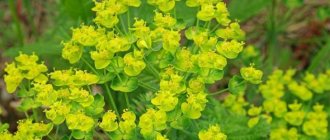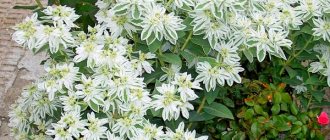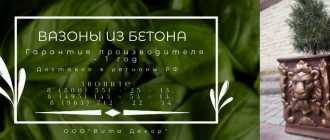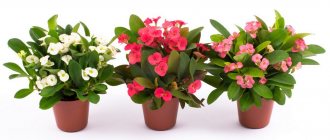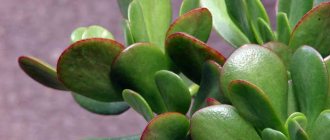Euphorbia , also called spurge , is the most numerous and well-known genus of plants related to the spurge family (Euphorbiaceae). It unites approximately 2 thousand very different plants. Such plants can be found in natural conditions in subtropical, tropical and temperate regions.
Most of these species are adapted for growing indoors. And the bulk of these plants come from the subtropics of Central America and Africa. Most are succulents, which have thick stems that can store water. When grown indoors, milkweeds are not afraid of low air humidity and irregular watering.
There are species that are very similar to cacti, for example, Euphorbia cereus or Euphorbia triangular. They also look like beautiful flowering plants (poinsettia).
Almost all types of euphorbia have juice containing toxic substances - euphorbine. Some species may be more poisonous, others less. This juice can leave a burn on the skin, lead to disruption of the gastrointestinal tract, and also cause inflammation of the mucous membranes of the nose and eyes. In this regard, during transplantation and propagation of such a plant, special care must be taken. Also, euphorbia should be placed in places that are difficult to reach for pets and small children.
Euphorbias are grateful for their popularity due to their very impressive form, low maintenance requirements, and also their durability. Most of these plants do not lose their attractive appearance even after many years.
Euphorbia - “not a cactus” with spines, transplantation and care
Planting and care
Euphorbia is a fairly unpretentious plant to care for. Loves sandy soils intended for succulents and cacti. The optimal ratio of sand, leaf soil and turf for milkweed is 2/2/3. A mixture of sand, turf and peat in equal proportions is also suitable. Drainage is required.
Euphorbia is transplanted in the spring. If the plant was purchased at another time of the year, it is better not to replant. A young plant can be replanted annually, and a mature one once every 2-3 years.
Feeding milkweed is done no more than once a month and only during the warm period. Mineral fertilizers for succulents or cacti are suitable for nutrition. The fertilizer concentration must be reduced by 2 times.
Euphorbia is a sun-loving plant and does not like drafts. In the summer, plants can be taken outside or onto the balcony. Euphorbia tolerates temperature drops down to +8. There are varieties that prefer direct sunlight, while others prefer partial shade. If you place the spurge correctly, it will delight you with its beautiful appearance. Sun-loving varieties can exist in the shade, but the lack of sun will affect the color of the leaves. In summer, plants can be taken out into the fresh air.
You can water euphorbia once a week in summer, and once a month in winter. This plant does not like excess moisture and is prone to rotting of the root system. If the soil is dry, then restore the moisture gradually; sudden, abundant watering will negatively affect the condition of the milkweed.
Most types of milkweed are disease resistant and do not attract pests. Of the parasites, spurge can attract scale insects. If this happens, you need to treat the plant with an insecticide.
General characteristics of milkweed
Succulents are distinguished by their ability to store moisture and nutrients in their stems and leaves. The entire Euphorbiaceae family has this skill. Due to their structure, these hardy plants easily survive seasonal and daily temperature fluctuations, as well as drought. On the territory of Russia there are 160 species of wild Euphorbiaceae: annual and perennial herbs, shrubs and something like small trees.
The plant received its Latin name - euphorbia - from the ancient Roman physician Euphorbus, who knew how to make valuable medicinal compounds from milkweed. The generic name - spurge - unites many types of flowers that differ in external characteristics. These subshrubs are covered with leaves or spines with regular, fleshy, cactus-like or faceted stems. Common to all species is the presence of poisonous milky sap in the tissues.
Succulents store moisture in their stems. They also have other types of adaptation to hot climates:
- a small number of stomata on the surface of the leaves;
- spines instead of leaf blades (reduce evaporation);
- predominantly night breathing (when the air is more humid).
All plants of the Euphorbiaceae genus are poisonous. When handling them, you should be careful: wear gloves when transplanting, grow in places inaccessible to children. It is unacceptable for juice to get into the eyes or gastrointestinal tract.
The flowers of the plant are small, devoid of petals. There is a pistil in the center, and 5 stamens grow around the sepals, representing modified anther flowers. The entire bouquet is collected in an umbrella inflorescence and is surrounded by several large bracts, which are colored and therefore look like petals. After flowering, a fruit is formed in the form of a triangular box with seeds-nuts.
The root system is powerful and branched. Alternate leaves with a smooth edge or jagged edges can be modified into hairs, thorns and prickles. Otherwise, indoor species of milkweed are strikingly different from each other. The most interesting of them require separate consideration.
Important! Read how to replant a cactus.
Reproduction
Euphorbia reproduces quite easily. Most often propagated by cuttings, but there are species (for example, white-veined) that are good to grow from seeds. Globular species of euphorbia are also propagated by seeds.
- We propagate by seeds. Milkweed seeds are in a capsule that ripens and cracks. To collect the seeds, place a fabric bag over the box. After collection, the seeds are dried on paper. For germination you need to purchase a sand-peat mixture. Plants are sown in separate pots. In order not to expose young shoots to infection, the soil must be disinfected and you should not sow euphorbia with other plants. The pot is placed in a dark place until shoots emerge.
- Propagation by cuttings. Good healthy shoots are suitable for propagation by cuttings. The lower part of the branch is cleared of leaves, washed of juice, wiped dry with a cloth, the cut is dipped in ash and dried for a couple of days. Then planted in moist soil. The pot is kept away from direct sunlight.
All types of milkweed are easily propagated, you just need to choose the right method.
Variety of species
The Euphorbia genus has about 800 species. Among them there are wild and domestic plants. Domestic crops are divided into outdoor and indoor crops. The forms and appearance of plants are so diverse that one can doubt their relationship.
Types of milkweed:
- Triangular spurge. This is one of the most common types. Ease of care and unpretentiousness have made it a frequent guest not only in residential premises, but also in public institutions. The shoots of triangular milkweed are fleshy, thick, and have knobs on the edges. The color is dark green. This species grows very quickly and can reach the ceiling in 4-5 years.
- Poinsettia. This species is also called the Most Beautiful. This spurge has very beautiful leaves. The lower ones are green, and the leaves of the inflorescences can be pink, white or red. The plant blooms with small flowers at the end of December. After flowering, Poinsettia sheds its leaves and loses its attractiveness for several months. This is a very capricious species to care for.
- Resinous spurge. This milkweed looks like a cactus. It looks like a bush of dense shoots. The branches are fleshy, green with four edges. There are small spines on each edge. Quite unpretentious appearance.
- Euphorbia Mile. This milkweed looks like a mini bush. The branches are not so fleshy, with a gray tint and purple spines are located on them. The leaves are green, oblong. It blooms with small bright flowers. Young plants look very pretty, but mature ones have bald branches and look more like a thorn bush.
- White headed spurge. It has a fleshy trunk, at the end of which there is a bunch of leaves. The leaves are large, oblong with white veins. This species blooms frequently and is capable of self-sowing.
- Large-horned spurge. It has a thick triangular stem with huge paired spines. Very often this species is considered a cactus. There are small leaves on the branches, but the plant quickly sheds them. Large-horned spurge blooms with small yellow flowers.
- Milk spurge. It has dense four-rib green branches. The ribs have a white coating in the form of stripes and small paired spines. Leaves appear, but do not develop and immediately dry out.
- Euphorbia Tirukalli. It has smooth green branches, cylindrical in shape. The thickness of the branches is up to 7 mm. The leaves are bright green, straight, falling. Leaf length up to 12 mm.
- Multi-thorned spurge. Has strongly branching shoots. The branches are four-ribed, bright green with a brown edge. On mature parts of branches the ribs are diffuse. Paired gray spines are located along all ribs.
- Schoolleaf spurge. It has powerful trunks reaching 7 cm in diameter. The height of milkweed is up to 25 cm. The trunks are covered with tubercles and outwardly resemble a conifer cone. At the end of the trunk there is a bunch of thin long leaves.
Description of euphorbia
Almost all species are suitable as an ornamental plant. The historical homeland of the vast majority of milkweeds is the subtropics of Africa and Central America.
Basically, these are succulents that can accumulate liquid; this advantage helps the plant not to be afraid of low air humidity or poor watering.
Euphorbia, the species of which amaze with their diversity, will surprise even experienced gardeners. For example, Euphorbia triangular is very similar to a cactus. But at the same time, there are also species such as poinsettia, which looks like a beautiful, bright decorative flower.
You might be interested in an article about how to care for poinsettia at home.
Euphorbia poison
Almost all types of euphorbia contain juice, which contains poisonous euphorbine. Depending on the plant variety, the poison may have varying degrees of health hazard.
The juice of the plant leaves burns on human skin, provokes inflammation of the mucous membrane of the nose or eyes, and if ingested, it disrupts the functioning of the digestive organs. Therefore, when contacting the plant, you need to be extremely careful and limit access to euphorbia to small children and pets.
Durability and effective form made gardeners fall in love with the euphorbia plant; caring for it, which does not require much effort, also played a role. Even after several years, it will delight the owner with its beauty and bright colors.
Read another interesting article about milkweed - “Euphorbia as a house flower.”
Types of euphorbia
Beautiful spurge
This is what they call poinsettia. This is one of the most common euphorbias among those grown at home. It begins to bloom towards the end of December.
It is not the flowers themselves that give poinsettia its spectacular appearance, but its variegated leaves, which can be colored red, white, or other colors. This is the most sensitive species among the others.
Euphorbia Mile
This low shrub with needles is also called the “crown of thorns.” During the first years of flowering, it looks very lively and bright, it is strewn with small flowers with red or light yellow bracts. The older the plant, the more it dries out.
Euphorbia plump
This species of euphorbia is a succulent that looks very much like a cactus, but without the needles. It has a spherical base on which the ribs are located.
Euphorbia bighorn
This is a weirdly shaped milkweed. It has triangular loose trunks ending in large needles of gray or brown shades, which grow on fresh shoots and quickly fall off.
Euphorbia triangularis
A fairly common species among all euphorbias. This type of milkweed has a tall, powerful, triangular-shaped trunk, with oblong leaves at the ends of the stems.
Euphorbia tirucalli
The tirucalli succulent is not at all difficult to care for. Its peculiarity is the absence of spines or leaves. The shoots of the plant look like small green sticks sticking out of the ground.
Euphorbia white-veined
The most common type of euphorbia. It has a rather distinct ribbed trunk, which is decorated on top with a small bush of dark green oblong leaves with whitish veins.
